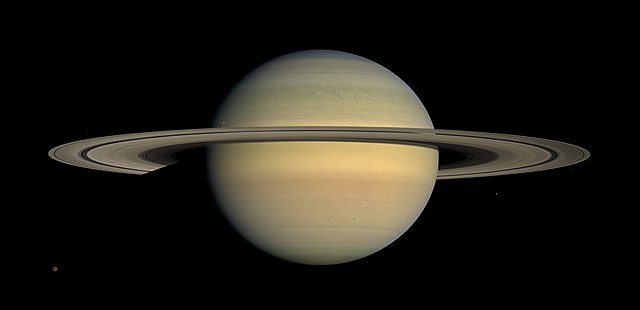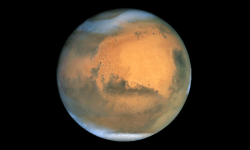
The rings of Saturn could disappear
– News of December 23, 2018 –
The rings of Saturn are superb but we are more and more certain that they are only temporary. They could have disappeared in a few hundred million years. A new study published December 17, 2018 describes how the inner part of the rings could slowly crumble under the effect of gravity and the magnetic field of the gas giant.
The grains of ice and dust that form the ring are normally stable, between the attraction of the planet and their own orbital velocity. They can, however, be ionized by solar winds or micro-meteorite impacts. The balance of forces then changes completely once the rings are ionized. The effects of the huge magnetosphere of the planet are important.
The grains of ice and dust are precipitated into the atmosphere of the planet along the lines of this magnetic field. This gives rise to a kind of rain of rings. The ice particles from the ring then interact with the atmosphere of Saturn. These interactions are at the origin of a surplus of ions and it is this surplus that has been observed by a team of astronomers.
This observation seems to show that Saturn eats slowly but regularly its rings. That would mean that they will not survive long. It may also be a sign that the rings of Saturn have formed quite recently. We can therefore consider that we are lucky to be able to see them.

The hexagonal shapes observable on Saturn are finally explained
– News of September 11, 2018 –
When the Voyager space probes flew over Saturn in the early 1980s, they made a startling discovery. At both poles of the planet, we can observe vortices, which is not surprising for a gas giant. But the vortex of the north pole of Saturn, observable during the summer of the planet, has a particular geometry. It is hexagonal, which is a form we are not used to seeing in the atmosphere of the planet Earth and any other body in the solar system.
Since its discovery, this strange vortex is still here. It was again observed by the Cassini space probe from 2006, during a new Saturnian summer. It is therefore a stable structure but which can still change. Between 2012 and 2016, it changed color, from a blue-green color to a golden orange color. Cassini, which has remained in Saturn’s orbit for 13 years, was able to make extensive observations of the phenomenon based on these data. A Franco-British team discovered a second hexagonal structure at higher altitude in the cloud mass of Saturn. It seems obvious that these two structures influence each other. It may even be a single phenomenon. The polar hexagon of Saturn could thus be a kind of gigantic tower. The hexagon itself is so big that the entire earth could dwell there. It is also assumed that its height is at least several hundred kilometers in altitude.
Seen from above, the poles of gas giants often have complex geometric shapes. The Juno spacecraft unveiled a set of fascinating vortices at Jupiter’s North Pole. But these structures are always curved, except on Saturn. A team from Oxford University thinks to have found an explanation. These forms could be due to different wind speeds at different latitudes. During a laboratory experiment, they put a fluid in rotation with different speeds at the center and at the periphery. This allowed the formation of geometric shapes with three, six or eight sides. The conditions of the speed differential must, however, be very precise. This may explain why such hexagonal structures have not been observed at the south pole of Saturn or on other planets.
The team at the origin of the discovery of the second vortex in altitude will unfortunately not have new data to explain this phenomenon. The anniversary of the end of the Cassini mission is approaching and there is currently no new mission planned for the Saturnian system. This could change next year with the selection of the next NASA New Frontiers mission. Among the two finalists there is a bold proposal that aims to send a drone on Titan, a moon of Saturn. It may be an opportunity to take some shots of its North Pole, if it’s the right season.
The consequences of the seasons on Saturn
The two hemispheres of Saturn have opposite seasons. When it’s summer in the north, it’s winter in the south. It does not have much to do with the earthly conceptions of summer and winter, but these names indicate when the longest or the shortest days take place. As a Saturnian year lasts almost thirty terrestrial years, the seasons are also much longer. Throughout its mission, the Cassini space probe was able to observe winter and spring in the north while in the south it was summer and fall.
Like the Earth, Saturn undergoes changes during the seasons. Wind speeds, temperatures and even cloud chemistry are influenced in the long term by the planet’s position in its orbit. Cassini completed its mission just after the summer solstice of the northern hemisphere. One of its last observations is therefore the change of colors of the hexagon of the North Pole. The gaseous giant’s atmosphere is thought to contain chemical compounds that react with light.
The essentials about Saturn
With Jupiter, Saturn is the other giant of the solar system. It is almost as big as Jupiter, but it is much less massive. Saturn is the least dense planet in the solar system. The atmosphere of Saturn is light and fast. There are very fast winds, 1800 km/h. In addition to its gigantic rings, we know that Saturn has 150 natural satellites. Most of them are only a few tens of kilometers in diameter. Saturn is the flatest planet in the solar system because its polar diameter is 10% smaller than its equatorial diameter. Despite its enormous size, its magnetic field is a little weaker than on Earth. Saturn is the last planet in the solar system visible to the naked eye from Earth.
Image by NASA / JPL / Space Science Institute [Public Domain], via Wikimedia Commons









